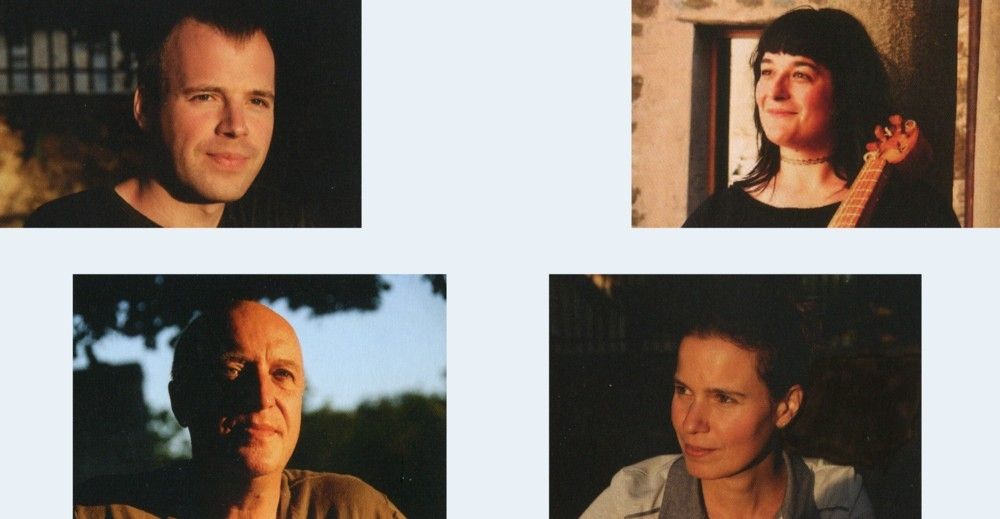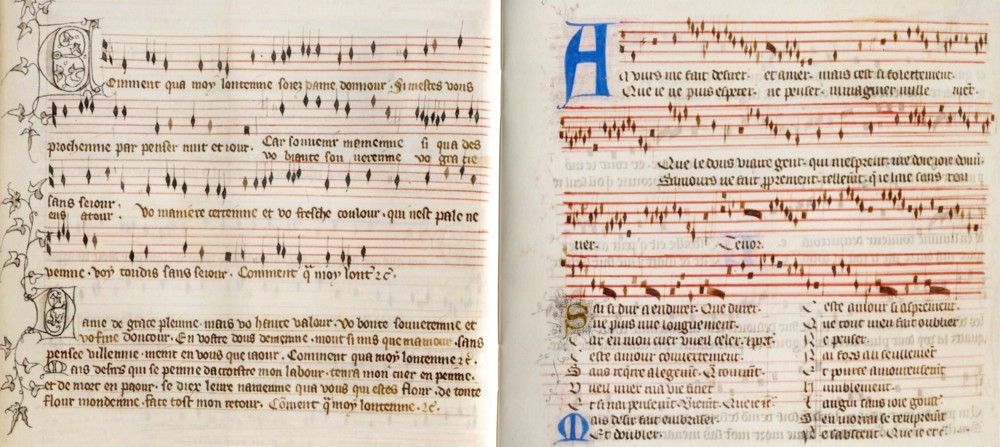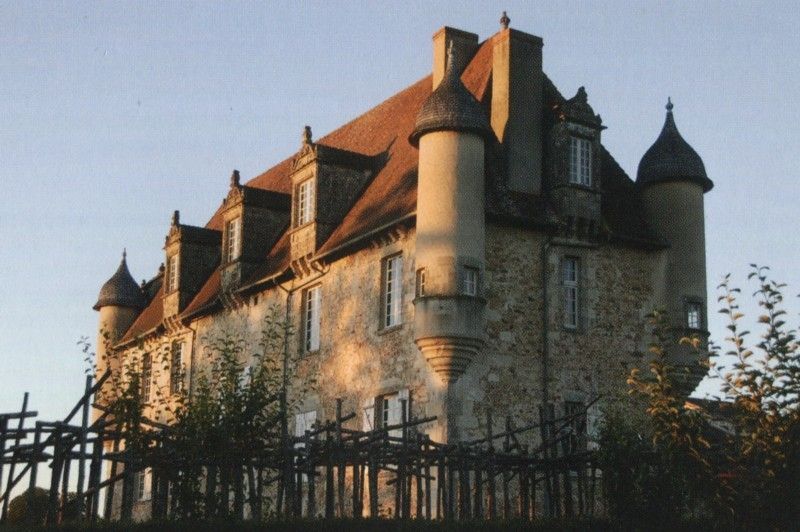Guillaume de MACHAUT. Virelais, ballades et rondeaux
Mon chant vous envoy
Marc Mauillon, Angélique Mauillon, Vivabiancaluna Biffi, Pierre Hamon

Eloquentia 1342
2012
virelai
1. Quant je suis mis au retour
[2:47]
MM, PH, MG, harpe, vièle, frestel, luth
virelai
2. Comment qu'à moy lonteinne
[4:42]
MM, AM, VB, harpe, vièle, flûte double, luth, organetto
rondeau
3. Puisqu'en oubli suis de vous, dous amis
[2:06]
AM, VB, MM
ballade
4. J'aim mieux languir [2:38]
harpe
ballade
5. Plourez, dames, plourez vostre servant
[7:32]
MM, VB, vièle
virelai
6. Dou mal qui m'a longuement
[4:12]
MM, harpe, ceterina
rondeau
7. Dix et sept, cinq, trese, quatorse et
quinse [3:35]
MM, VB, harpe
virelai
8. Dame, vostre ous viaire
[6:06]
MM, harpe, vièle, flûte traversière
ballade
9. Phyton, le mervilleus serpent
[6:13]
MM, vièle, harpe
ballade
10. Amours me fait désirer (texte)
[2:16]
MM (voix récitée), luth
ballade
11. Amours me fait désirer
[4:41]
VB, vièle, flûte à bec
virelai
12. Se ma dame m'a guerpi
[4:36]
MM, flûte traversière
13. Et musique est une science
[1:14]
organetto
prologue
14. Loyauté weil tous jours
[0:42]
MM · voix parlée
virelai
15. Liement me déport
[5:39]
harpe, vièle, ceterina, organetto, flûtes à
trois trous et tambour, tambourin
virelai
16. J'aim sans penser laidure
[2:11]
MM, vièle, harpe, luth, flûtes à trois trous et
tambour, organetto, tambourin

Marc Mauillon, voix MM—1, 2, 3, 5, 6, 7, 8, 9, 10, 12, 14,
16
Vivabiancaluna Biffi, voix VB—2, 3, 7, 11, et vièle—1,
2, 8, 9, 11, 15, 16
Angélique Mauillon, harpe—1, 2, 4, 6, 7, 8,
9, 15, 16 et voix AM—2, 3
Pierre Hamon, flûte médiéval à bec—11,
flûte médiéval traversière—8,
12,
flûte double—2, flûtes à trois
trous et tambour—15, 16, frestel—1, voix
PH—1, et
direction musicale
Michaël Grébil, luth—1, 2, 6, 10, 16, ceterina—6,
15 et voix MG—1
Catalina Vicens, organetto—2, 13, 15, 16
Carlo Rizzo, tambourin—15, 16
Recorded in july 2012 at the Fondation Laborie en Limousin, Limoges, France
Producer engineer & editing: Laurence Heym
Liner notes by Elizabeth Eva Leach & Pierre Hamon
Translation by Doriane Heym (Franšais) & Mary Pardoe (English)
Cover photo @ Doriane Heym

'How is it that more than seven hundred years later these sequences
of notes can have such an impact? This is a mystery to me. Although the
original lyrics often seem overwrought, the music is extraordinarily
fresh. The melodies and harmonies are far from today's classical music
conventions, yet they speak even more directly and profoundly'.
Robert Sadin
in the introduction to the magnificent album 'Art of Love: Music of
Machaut' (Robert Sadin, with an extraordinary array of contemporary
artists, including Mark Feldman, Hassan Hakmoun, John Ellis, Madeleine
Peyroux, Nathalie Merchant, Lionel Loueke, Brad Mehldau, Milton
Nascimento, Cyro Baptista); Deutsche Grammophon, 2010.
Ce mystère «Machaut», qui ne cesse de nous fasciner
également, nous a incités, dans nos deux
précédents enregistrements, L'Amoureus tourment
et Le Remède de Fortune, à l'exploration de
formes longues comme le lai et la complainte, où la
poésie et la musique naturelle des mots nous ont convaincus de
l'importance de donner à entendre ces œuvres dans leur
intégralité, la poésie étant en constant
dialogue avec la mélodie, l'une éclairant l'autre.
S'il est vrai que Guillaume de Machaut appelle lui-même vieille
et nouvelle forge les anciennes et nouvelles manières de
composer, notre intuition est que la modernité du chanoine de
Reims n'est peut-être pas là où on l'attend
généralement - à savoir, dans un avant-gardisme du
contrepoint et de la polyphonie et dans la complexité de son
écriture. Sa véritable «modernité», ou
plutôt son humanité dans les émotions, les
questions qu'il pose sur la vie, l'amour, la création
artistique, se révèle peut-être encore mieux dans
ses chansons.
Guillaume de Machaut, célébré en son temps
à la fois comme le plus grand poète et le plus grand
compositeur français du XlVe siècle, a malheureusement,
par un revers de fortune, souffert de ce double statut qu'il est le
dernier à posséder. Lors de sa redécouverte au
XIXe siècle, puis au cours du XXe siècle, «le
dernier trouvère» a été analysé et
étudié comme poète dans les cercles
littéraires, bien sûr inaptes à considérer
sa musique, ou comme compositeur extrêmement savant par les
musicologues et compositeurs d'avant-garde, fascinés par sa
science du contrepoint. Un intérêt initial
disproportionné (selon les termes de la musicologue Elizabeth
Eva Leach, qui nous a fait l'honneur d'écrire la
présentation de ce disque) pour sa Messe, ainsi que pour les
structures rythmiques complexes de ses motets, où la
présence simultanée de plusieurs textes, et donc la
difficulté de saisir et d'entendre clairement la poésie,
a contribué á faire attribuer la
célébrité de Machaut d'abord à sa
virtuosité de compositeur, et à fausser son image.
Certes, notre univers culturel est très éloigné de
celui de Machaut, qui a pour références Boèce, la
mythologie antique, le Roman de la rose, etc. Mais, comme aujourd'hui,
le XlVe siècle est une époque inquiète
bouleversée par de grandes catastrophes (grande peste),
instable, avec, dans les arts vivants, le passage de l'oralité
au livre - plus qu'aucun autre, Machaut y est particulièrement
sensible, lui qui veille lui-même à la facture et à
l'enluminure de ses manuscrits. C'est une époque où le
livre est un nouveau média. On peut le lire publiquement ou dans
l'intimité de la chambre, admirer ses enluminures, en extraire,
pour le chanter, un lai, une ballade ou un virelai, danser sur ce
dernier, ou encore tout simplement lire les poèmes à voix
haute ou en silence, mentalement - ce qui est par ailleurs une pratique
encore récente au XlVe siècle.
Nous sommes convaincus de l'intemporalité de ces œuvres,
et en particulier de ces petites «chansons
balladées». Ce qui nous touche aujourd'hui, en
écoutant et en chantant Machaut, c'est peut-être, avant
tout, le pouvoir de consolation de la musique, qui agit sur l'âme
du poète, dont les paroles s'avèrent étonnamment
proches de notre sensibilité. La musique réchauffe et
«réjouit» un cœur inquiet qui interroge le
destin, les mystères du sort et les tourments de l'amour.
Partout ou elle est, joie y porte;
Les desconfortez reconforte,
Et nes seulement de l'oïr.
Fait elle les gens resjoir.
Pierre Hamon

Guillaume de Machaut (c.1300-1377) was the foremost poet and composer
of fourteenth-century France. He was an extraordinary creative artist,
who by the middle decades of the fourteenth century had already
composed a substantial body of literary and musical works, to which he
added until his death in 1377. His contemporaries recognized him as one
of the greatest writers of his day and his reputation as a poet lasted
for some time after his death, which was commemorated in music and
poetry. He was patronized by royalty and his works were performed and
read throughout Europe. His narrative poems marry clerkly didacticism
with the most fashionable traditions in love poetry, and they develop a
first-person narrative persona that greatly influenced Chaucer,
Froissart, Christine de Pizan, and other vernacular authors. Unlike
those poets, however, he set more than a hundred of his own lyrics to
music, helping to establish the lyrico-musical forms of balade,
rondeau, and virelai, which, by the end of the century, came to be
called the formes fixes. He also wrote expansive polytextual
motets in a fashion pioneered by his contemporary Philippe de Vitry,
which modern musicology calls "ars nova." Machaut's is also the first
surviving polyphonic setting of the cycle of the Mass ordinary that is
known to be by a single composer. In terms of number of lines, his
narrative verse places him among the most prolific poets of his age.
More musical pieces survive by him than are known to be by any other
French composer of this period. His training for being a court
secretary may have been formative in his practice of a distinctly
scribal authorial poetics, which led him to oversee the copying of his
own works: his complete works survive in several large manuscripts from
his lifetime, some of which seem to have been prepared to Machaut's own
specifications. These sources advance the artistic use of the book for
vernacular poetry, making play with mise-en-page, internal
cross-referencing and paratextual features such as indexes and rubrics.
Machaut's works can be seen as the logical conclusion of the troubadour
and trouvère tradition in which scribal reverence for a body of
works has been exercised not by later collectors but by the author
himself. If he didn't invent it, Machaut certainly bolstered and
enshrined the idea of the vernacular author-figure, complete with a
problematic and ironic relationship to his own poetry's truth-value.
For Machaut, written authorship directs both the oral arts: poetry and
music. At no other point in time was a single person so central to the
histories of both European literature and European music in all its
then-current genres.
Despite his reputation and the sizeable body of works that he has left,
the more workaday details that pertain to the man behind the artist are
hard to extract. We have a good number of luxury manuscripts of
Machaut's work, most now available for viewing online (see the list at
http://www.stanford.edu/group/dmstech/cgi-bin/drupal/machautmss). The archival evidence is more
scanty, mostly pertaining to monetary aspects of Machaut's life such as
employment, patronage, taxation, and the receipt of gifts. But a large
number of fairly basic questions remain. The dates of Machaut's birth
and death are unknown. His birthplace, early schooling, training, and
route into the service of his only known employer, King John of
Bohemia, remain obscure, as does the precise employment in which he
engaged after John's death in 1346.
As a poet, Machaut is important but far from unique -- the aspect of
his work that differentiates him from his contemporaries is the central
role of music within his literary output. Machaut was not incidentally
"also a composer" -- his music is not a meaningless ornament to his
lyrics. Instead, as the importance of Orpheus to Machaut's narratives
of desire, love, loss, and mourning shows, his music transforms his
lyric. Music's performative reading of poetry, its links to human
emotion, and its place as a very specific kind of knowledge in medieval
society, allowed Machaut to go beyond his contemporaries in responding
to the needs of his readers for entertaining edification and effective
consolation in the central matters of life, love, and death.
Most of the tracks on this disc are performances of Machaut's virelais,
a genre that Machaut preferred to term chanson baladée ("danced
song"). The form is a simple one, but flexible enough to sustain a wide
variety of verse forms and the music is often monophonic and memorable.
We can imagine the kind of situation described in Machaut's Remede
de Fortune where the lover sings a virelai with his lady and her
courtiers in a round dance on the meadow outside her chateau. Virelais
start with a refrain and then proceed to a pair of verses before
returning to the music of the refrain, but with new words (the
"tierce"). When they hear the familiar music of the refrain with the
tierce text, the courtiers dancing will be in no doubt when the tierce
finishes (because they know the tune), so they know exactly when to
join back in for the refrain again.
The present disc contains a reading from Machaut's so-called Prologue,
a confection of illuminations, lyrics, and narrative poetry which he
wrote late in his life to stand at the head of the manuscript of his
collected works. The Prologue mentions all the genres of song that
follow it in the manuscripts. It can be understood as a statement of
the author's musical poetics designed as a key to his entire output,
specifically discussing the role of emotional
authenticity—sentement—in the creation of musical lyrics.
This emotion can be seen throughout the songs here, especially in
Machaut's Ploures, dames (B32) a kind of auto-testament, in
which the je threatens to die if the ladies of the court don't take
care of him. The music sets the doleful words to jaunty dance-like
triple rhythms, here lacking the joyfulness that they would normally
have as a way of depicting the malady of the singer. Angular lines,
leaps to sharpened notes, and sudden held sonorities all add to the
sense that something is not quite right, while at the same time giving
a warped window onto the ordinarily joyful song that the ladies will be
deprived of if they don't rescue the je from death's door.
Ploures, dames (B32) is one of Machaut's balades, a serious
high-style composition in a direct stylistic descent from the grand
chant of the trouvères. Of the other balades on this disc, the
late Phyton (B38) most clearly shows the seriousness of this lyric
genre, since it draws on the tale of Phiton, the serpent, from the
Ovide moralisé, which it adapts to depict the lady's many-headed
forms of rejection of the je's love. In Amour me fait
desirer (B19) the personified Amours makes the lover desire and
love so that he is unable to hope or think. The poem is here read aloud
as recitation and then performed musically, enabling the listener to
appreciate the additional layers of meaning that the music supplies.
Both "desirer / Et amer" and "esperen / Ne penser" have the same music,
making an aural parallel between the cause of grief (desire) and its
cure (hope). Musically, Love makes the singer "desire" too. The
counterpoint setting the opening word, "Amours," forces the singer to
perform a very unusual melodic interval at the outset of the piece,
from G to c#, offering a strange bisection of the overall G to g octave
range of the first phrase. This c# has contrapuntal "appetite," or
"desire," for resolution to d. Ultimately, Machaut's music becomes the
ultimate surrogate for erotic desire and means of achieving a serene
life.
Elizabeth Eva LEACH





